Multiple Sensory Elements of Classrooms
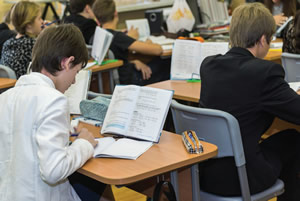
PHOTO © VLADIMIR ARBESMAN/SHUTTERSTOCK
It is understandable that a teacher or parent might think that a child who is sitting quietly and “still” is a child who is listening, learning and participating. We socialize children to develop the necessary personal habits and routines that are meant to help them “fit in” and to be able to “take in” information so that they can develop skills and concepts. As part of these good intentions, over time we have come to expect that children will sit still in the classroom, thinking that this reflects good behavior associated with learning and participating at school. One feature of these efforts is that children in classrooms generally sit in four-legged, stable chairs at desks, which are all the same size. However, if we look around at the ways adults set up and engage in their learning and working environments, we rarely see these elements in their furniture. Rather, adults sit in height-adjustable chairs that swivel, roll and flex at desks that offer organized and flexible work areas.
Ultimately, our brains and bodies are wired to be active during the day. We naturally stretch, lean, turn, bend and move-almost continually while we are awake. Adults sitting in office-style chairs at their desks, tend to lean back, gently turn side to side and adjust their positions while they use computers, talk on the phone or meet with colleagues. Whether consciously or not, most also get up and walk around-to ask a question, pick up a document at a printer or to retrieve a file from a drawer after they have been sitting for a while.

PHOTO © WAVEBREAKMEDIA/SHUTTERSTOCK
In fact, when we keep our bodies still, our brains are programmed to think it is time to go to sleep — a state that is not appropriate for either work or school. However, when children seek some of the same body and head motions that adults receive through their natural actions in tasks, there is a tendency to see them as ‘fidgety,” distracted, inattentive and even disruptive.
Furniture that is not the right size contributes to interruptions in attention and participation, as well as poor body mechanics and muscle and joint strains. A 1999 study by Parcels, Stommel and Hubbard reported that fewer than 20 percent of the 6 to 8 grade students in their study had appropriately sized furniture, concluding that many students must, “endure seating arrangements in their classrooms that are not conducive to learning.” Ensuring that children have classroom furniture that is the appropriate size for good body mechanics and positioning is especially important, since children are now spending more time in sedentary postures than ever before.
Although advances in technology bring many advantages and opportunities for enhanced learning for children, increased time spent with technological devices is a part of this challenge. A study in 2000, by Subrahmanyam, Kraut, Greenfield, and Gross, examined the use of home computers on children’s activities and development and stated that, “As the combined amount of time children spend across these various media increases, the likelihood of displacing time spent on organized sports and other social activities also increases, thus exacerbating the impact on children’s physical and social well-being.”
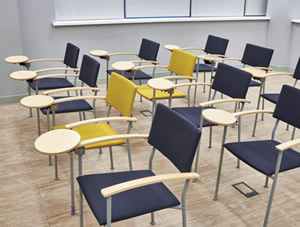
PHOTO © SERGEY RYZHOV/SHUTTERSTOCK
They note the potential for increased risk of obesity, hand injuries and decreased play skills with increased time in front of computer screens. Decreased opportunities for physical activity and increased tendency toward sedentary activities have occurred for all people in the U.S. and for developing children in particular, with U.S. Center for Disease Control naming increased physical activity as a major objective. The fact that both attention and behavior have been associated with academic performance suggested that these are important aspects of consideration for supporting children’s learning.
As a variety of trends have converged to increase time spent in sitting, while concurrently more and more students are identified with problems in attention and learning, finding new ways to address these concerns is critical.
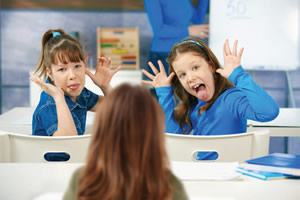
PHOTO © STOCKLITE/SHUTTERSTOCK
Evidence Concerning Ball Chairs and Inflated Cushions in Elementary School Classrooms
Occupational therapists commonly work in school settings to support children with special needs, as well and to prevent concerns through early identification and intervention. Our observations of children in classrooms sitting on traditional, static furniture reveal that students of all ages tend to instinctively seek some motion while sitting, most likely as a means to stay alert and engaged. Many children tend to tilt backwards, sway side-to -ide and lean while seated in four-legged, stable chairs. For some students, the need to move during seated activities can become disruptive, and even a safety concern, if they tilt or lean too extremely.
As occupational therapists have recognized the need to provide options for movement while sitting to children with special needs, they have studied the impact of offering classroom seating on therapy/exercise balls and inflated cushions. The results of these research studies are somewhat mixed, but are overall favorable.
For example, several single-subject design studies using therapy balls instead of stable chairs have been published. In 2003, Schilling, Washington, Billingsley and Deitz studied the results of using therapy balls with three students and found increased in-seat behavior and legible word productivity. In 2004, Schilling and Schwartz studied the impact of stability ball chairs with four children who were diagnosed with autism and reported increased engagement and in-seat behavior with stability ball chairs.

PHOTO © SANNA BABURKINA/SHUTTERSTOCK
In 2011, Fedewa and Erwin studied eight children in fourth and fifth grade and found an increased level of attention, decreased hyperactivity and increased time on task with stability balls. In all of these studies, both the teachers and children reported preferences for the balls or ball chairs over the stable chairs after using them in the studies. Bagatelle, Mirlgliani, Patterson and Test, in 2010, reported mixed results using ball chairs with stability rings with six boys with autism with positive results for the child with the most extreme movement seeking behaviors. However, in their study, children with poor postural stability were less engaged while sitting on the balls.
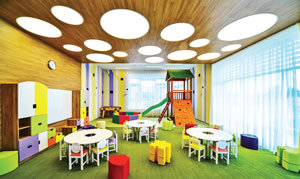
PHOTO © STOCK_SHOT/SHUTTERSTOCK
Other research with inflated cushions used on chairs also shows the potential benefits of offering some motion while seated. For example, in 2008, Pfeiffer, Henry, Miller and Witherell conducted a large randomized clinical trial study with 63 second graders who were diagnosed with ADHD. In their study, they used a “Disc O Sit” cushion for 2 weeks and found statistically increased attention after introduction these supports for moving while sitting in the classroom. However, in 2011, Umeda, C., and Deitz, J., in a small, single-subject study with two boys, found no clinically relevant changes for in-seat behavior for those students.
Consideration of these results was intriguing. If providing options for dynamic movement in sitting through the use of therapy balls and inflated cushions had generally favorable results, further applications seemed worthwhile. However, management and acceptance of the therapy balls and cushions had limitations for both regular and special education classrooms. The availability of dynamic or “healthy movement” furniture offered the opportunity to further consider the effects of positive sensory supports on attention and learning.
Evidence for Re-Designed Classrooms with Sensory Supports and Dynamic Furniture Methods
In order to consider the effects of designing classrooms to support the overall sensory needs of elementary school-aged children, two projects were conducted. In the first project, three second-grade classrooms were selected for study. In this project, two of the classrooms were chosen to be “redesigned” (classrooms A and B) and one classroom served as a control (classroom C). Classrooms A and B received “dynamic” seating (task or “swivel chairs,” rocking chairs and chairs with a flexible back), as well as regular-height individual tables or “lab (higher that typical) tables that also had swivel chairs or “lab” stools at the same height as the tables. Color combinations were chosen by the teachers. In addition, shelving and cabinetry were selected to increase organization and reduce visual and physical clutter in the classrooms. Finally, carpeting was installed to reduce noise. Children in all three classrooms were observed for specific “seating” behaviors during a two-week baseline period before the furniture was delivered and for six weeks after Classrooms A and B were redesigned. The seating behaviors compared from baseline to after the redesign in the first project are shown in Table 1.
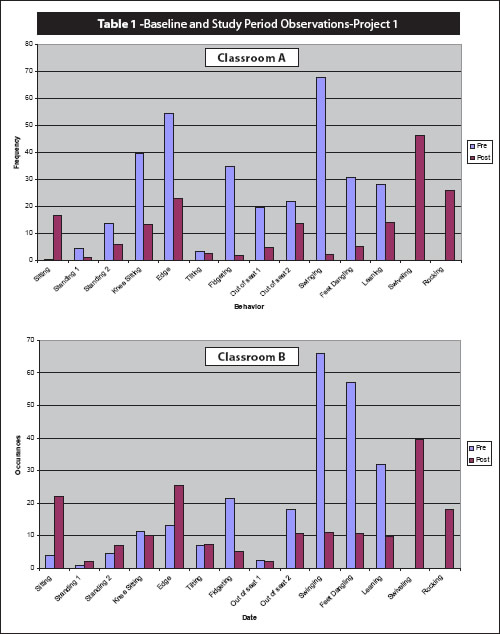
PHOTOS COURTESY OF DR. ZOE MAILLOUX
In the second project, two additional classrooms (D and E) were redesigned in similar ways. In this project there was not a control classroom. However, observations were made again for a two-week baseline period prior to the classroom redesign, and then for five to six weeks after the classroom changes were made and the furniture was in place. In this project, the observations were revised to be more consistent with a common school-based observational tool, the Behavioral Observation of Students in Schools (BOSS). See Table 2 for the behaviors observed in the second project.
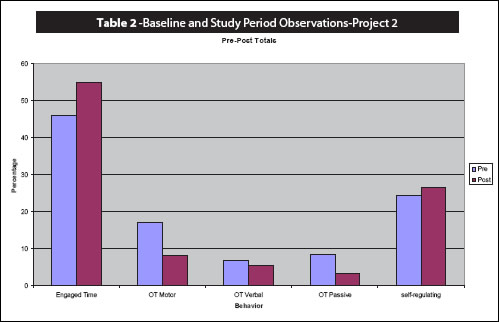
PHOTOS COURTESY OF DR. ZOE MAILLOUX
In both Project 1 and 2, teachers were provided with education and training on topics such as the role of various types of sensation (movement, touch, joint traction and compression, sights, sounds and smells) on learning; how to create a “sensory friendly” learning environment and ergonomics in the classroom. Students were also prepared for the changes and presented with some basic rules for their new classrooms (e.g. “Chairs stay at your desk and in your personal space” and “Chairs are for sitting and learning — it is a special privilege that they are allowed to try these new chairs.”)
Results
Project 1: The following seated behaviors showed changes in the re-designed classrooms (A and B) in comparison to the control classroom (C) and also from baseline to the post furniture period:
Increases in:
Sitting — feet flat on the floor — suggesting that the children used better ergonomics when seated in the dynamic furniture
Decreases in:
Sensory seeking behaviors that were considered distracting, such as:
Knee sitting — sitting on one or both knees
Edge sitting — bottom on less than 50% of the chair
Leg swinging: One or both legs swinging under chair
Out of seat without a purpose (i.e. wandering classroom)
In addition to the improved seating behaviors observed in the redesigned classrooms, progress report scores were also more favorable, with students showing increased scores of “excellent and very good” and a decrease in “satisfactory/needs improvement” from baseline to the study period and in comparison to the control classroom.
Project 2: In both Classrooms D and E, observations of the student before and after the changes were made in the classrooms demonstrated:
Increases in:
Active Engaged Behavior
Decreases in:
Off-Task Verbal
Off-Task Passive
Off-Task Motor
Almost no Passive Engaged behavior was seen either before or after the classrooms were redesigned.
Follow-up with teachers and students also suggested a generally favorable response to the re-design. While teachers were universally hesitant and skeptical about introducing student chairs that swiveled, rocked and rolled, all of the teachers reported feeling positively about the furniture and re-design elements in their classrooms. Although all of the teachers in the four redesigned classrooms were offered new, stable furniture at the end of the project if they were not happy with the dynamic furniture, none wished to revert to the stable chairs. The teacher in the control classroom also selected dynamic furniture at the end of the project.
A summary of the feedback about the positive aspects of the furniture included:
- Allows movement without being too distracting
- Adjustable height
- Easy to move around the classroom
- Swivel allows children to rotate to look at boards or instructor in different places in the room
- If child heavier the vertical movement on the chair from bouncing is beneficial
One teacher noted:
“The furniture helped my students to focus by providing them with the opportunity to move, swivel and rock. The standing tables, high lab stools and rocking chairs were very popular. The tables allow for flexible grouping and are great for collaborative learning activities. My room is perfectly organized and appealing thanks to bookshelves and cabinets that allow the students to keep all the important supplies without cluttering up their desks.”
The students were very vocal about feeling positively about the furniture. Their comments included:
“Thank you for the amazing furniture. I love how everybody has their own desk. I also like how the chairs move around. The furniture helps me pay attention.”
Another child wrote:
“The chairs make me feel better. It helps calm me down. I am very happy in these chairs.”
In summary, when classrooms were re-designed to offer positive sensory supports and to reduce sensory-based distractions, significant positive changes in student behavior were recorded. In both projects, the students in the re-designed classrooms had improved in seat and on-task behavior compared to the conditions in which students were in traditional classrooms.
Conclusion
Appropriate dynamic furniture provides support for the types of motion and flexibility that adults have demanded in their office furniture for decades. Children in school need and deserve these basic supports, as well. Consideration of the multiple sensory elements of classrooms can be a crucial step toward reducing negative behaviors and increasing positive behaviors that support attention and learning. Truly modern classrooms of the 21st century will recognize the sensory needs of all children and will provide ergonomically appropriate furniture, allowing students to use emerging technology, to access information from various points of instruction and to fluidly move around for collaborative and experiential learning experiences.
This article originally appeared in the issue of .